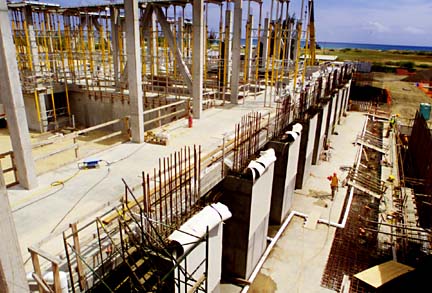
DEAN SENSUI / APRIL 2003
A portion of the new sewage treatment plant under construction at Sand Island includes this ultraviolet treatment plant.
City trucking
sewage to Waianae
waste-water plantThe shift is to make sure the
Sand Island plant is not in violationWork under way
The city is using an unconventional method to make sure its Sand Island Wastewater Treatment Plant does not violate its federal permit for discharging treated sewage into the ocean.
"As needed," it is trucking some of Sand Island's sewage to the Waianae Wastewater Treatment Plant, according to a May 1 city report to the Environmental Protection Agency.
What is being hauled is called centrate. It is the liquid left over when sewage sludge is spun in a centrifuge to dry it to a solid, dirtlike material that is trucked to a landfill for burial.
Libby Stoddard, an inspector for the state Department of Health's Clean Water Branch, called centrate "the most concentrated, nastiest stuff."
This is not the first time the city is hauling centrate to another plant. In February 2001 and again in December 2002, the city trucked centrate from Sand Island to Waianae to comply with its permit requirements for organic pollutants but only told regulators about it afterward, said Stoddard and Jo Ann Cola, an EPA clean-water compliance officer.
The city may have hauled up to 30,000 gallons a day of centrate from Sand Island to Waianae for up to 11 days in February 2001, Stoddard said. Health Department records indicate that this transfer "appeared to have resulted in Waianae not having compliance" with its EPA permit limits.
On Thursday, Cola said she is going to research whether the EPA has rules about moving centrate from one plant to another. "It's not a common practice, not that I'm aware," she said.
If daily monitoring shows the Sand Island plant is getting close to violating its permit limits for organic pollutants in its effluent, workers will be "hauling centrate to another facility, primarily Waianae Wastewater Treatment Plant," the city's report says.
"I have no independent knowledge of it," state Sen. Colleen Hanabusa (D, Waianae) said of the city's trucking practice. "But if this is what they're doing, the City and County of Honolulu is again dumping on the Waianae Coast. It has always been the convenient dumping ground for its rubbish."
Hanabusa is suing the city, alleging that it did not adequately investigate alternatives to expanding its Waimanalo Gulch Landfill, also on the Waianae Coast.
It was during a joint EPA and state inspection of the Sand Island plant in February that regulators learned of the December 2002 hauling of centrate from Sand Island, they said.
In September the EPA criticized the Sand Island plant for violating its effluent limits on dieldrin and chlordane (two banned pesticides) and enterococcus (a disease-causing virus), for operations and maintenance violations and for being behind schedule on its plant upgrade.
The city has not violated EPA requirements for reducing the organic pollutants at Sand Island since 1999, its report says.
In December the city outlined for the EPA how it would improve its compliance, but in March, EPA told the city its response was inadequate. The city's May 1 report is its revised response to the EPA.
Regulators Cola and Stoddard said they cannot comment on the city's May 1 report until they have reviewed it and responded to the city, which could take several weeks.
"We're working with them, trying to get to a point where they'll be in compliance with their permit," Cola said. "It's a cooperative effort."
In addition to trying to avert potential fines for noncompliance with its current permit, which expires in November, the city has to apply for a new five-year permit.
City officials will not comment on the Sand Island situation until after they meet with the EPA next week, spokeswoman Carol Costa said.
The city is making $348 million in improvements to the Sand Island plant and has faced serious obstacles that put it behind schedule in four of eight components of the massive project, it says in its report.
The Sand Island plant is the largest of the city's four sewage treatment plants, processing about 75 million gallons a day, or 64 percent of the city's total. The Waianae plant processes 3 million gallons a day, or less than 3 percent of the city's total.
City & County of Honolulu
BACK TO TOP |
Work under way
at Sand Isle plantHere is a look at the work in progress at the Sand Island Wastewater Treatment Plant, including the project name, cost, status and/or planned completion date. (Bold-faced projects are behind schedule.)
>> Hart Street Force Main, $23.3 million, complete.
>> Sand Island Interim Chemical Facility, $1.5 million, complete.
>> Sand Island Ultraviolet Disinfection, $77.5 million, 74 percent done, due October 2004.
>> Sand Island Headworks (filtering process), $88.7 million, 38 percent done, due March 2005.
>> Hart Street Pump Station, $23.4 million, 35 percent done, due February 2005.
>> Sand Island Parkway Pump Station, $1 million, work to begin this month, due February 2005.
>> Ala Moana Pump Station, $23 million, work to start in October, due February 2006.
>> Sand Island Expansion, $110 million, work to start in December 2004, due August 2007.
Source: City report to the Environmental Protection Agency
